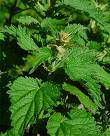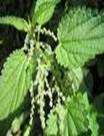Scientific Classification:
|
Other Common Names:
The other common names for the herb nettle are Chinese Nettle, Stinging Nettle, Great Nettle, Hsieh-tzu-ts'ao, Devil's Leaf, Net Plant and Dwarf Nettle.History


Description


Range
The nettle plant though said to be a native of temperate regions it is believed to be brought from England by John Josselyn.It also grows wild in southern Africa, and in the Andes, and even in areas of Australia. Nettle is mainly concentrated in the Northern hemisphere. The plant is also found in Japan.Habitat
This hardy plant is seen on nature walks throughout temperate regions. It is very common growing near hedges and on waste ground.Cultivation
Basically the nettle is considered a weed, most people don't bother to cultivate them. They have a perennial root system that spreads quickly and makes it very difficult to eradicate once it's established. You can collect seeds from the wild and then divide roots at any time of the year. It is possible to "earth up" the plants to blanch them like seakale. Gloves and a knife or scissors are used when harvesting. The whole herb can be collected in May and June, just before coming into flower, and dried in bunches or frozen. Collect seeds when they are ripe. During the summer season, the aerial parts of the herb and especially the leaves are plucked when the plant is in full bloom. Autumn is the time when nettle roots are harvested and used in the preparation of various herbal remedies.Flowering Season
The flowers of the plant nettle are in full bloom between early summers to early autumn.Pests and Diseases
Nettles are very competitive and weed control is not necessary where the crop establishes well. Poorer soils where nettles do not establish as well may allow weeds such as thistles and dandelions to suppress development and create contamination. The pests and diseases affecting the crop are unknown.Mildew,aphids and butterfly larvae are seen on some cultivars.
Parts Used
 |
The roots and mainly the aerial parts of the nettle plant are of medicinal and commercial use. |
Medicinal Applications
- The roots and leaves, are used for the treatment of asthma, wheezing and short breath by opening up the passage of lungs.
- It helps to expectorate phlegm and to raise the imposthumed pleurisy.
- As a gargle it helps the swelling of the mouth and throat.
- A decoction of the leaves provokes the courses and urine and expels gravel and stone.
- It kills worms in children, eases pain in the sides and dissolves wind in the spleen.
- The seed taken as a drink is remedy against the bites of dogs, cleansing the body of all accumulated toxins and in the rapid removal of metabolic waste.
- The juice of the leaves or a decoction of the root is used as a wash for fistulas and gangrenes and for corroding scabs or itch.
- The leaves are helpful in treating high blood pressure, cystitis and anemia.
- It also acts as a blood purifier.
- The roots are also used in treating diarrhoea, dysentery and inflammation and ulcerations affecting the digestive tract.
- It is claimed to stimulate the growth of hair in persons who are suffering from hair loss and gives natural colour to hair.
- Nettle helps in curing rheumatism, arthritis, gout and skin infections.
- Tonics are manufactured for the treatment of physical weakness.
- Bleeding in any area of the body is treatable by the strong astringent action of the nettle.
- It is also used in treating burns and scald injuries.
- The leaves help in anemia and improve breast-milk production.
- The root is now used to treat enlarged prostate. Abscess, Addictions and Herpes.
Commercial Applications

- Culinary uses of the herb are also many, and the young nettle shoots are very edible, and these are often cooked to make delicious herbal dishes.
- The tough fibers from the plant stem have been used to make cloth, and stalks are strong and can be woven to make sails or twine.
- Nettles were also used in green camouflage paint.
- Using Nettle tea to water garden plants stimulates their growth and makes them more resistant to bugs.
- When lactating animals are fed Nettles, they are said to produce more milk, and chickens produce more eggs.
- It used in topical applications like shampoo, conditioner, hair rinse for dandruff, as a cleanser for oily skin and as an astringent facial cleaner.
Influence of Nettle on language and culture
In Great Britain the stinging nettle is the only common stinging plant, and has found a place in several figures of speech in the English language. To "nettle" someone is to annoy them. Shakespeare's Hotspur urges that "out of this nettle, (danger), we grasp this flower (safety). The common figure of speech "to grasp the nettle" probably originated as a condensation of this quotation. It means to face up to or take on a problem that has been ignored or deferred.
Folklore and Myths
The fairy tale named "The Princess and the Eleven Swans" by Hans Andersons tells the coats she wove for them were made of nettles. Folklores say that a fever could be dispelled by plucking a Nettle up by its roots, reciting therby the names of the sick man and also the names of his family. Nettle is considered to be one of the nine sacred herbs, along with mugwort, plantain, watercress, chamomile, crab apple, chervil, and fennel. Nettle is a strong Jinx-Breaker. When mixed with uncrossing herb, such as Mint, Rue, Wahoo, or Agrimony, plus a Jinx-Breaking Mineral, like Witch's Salt, Graveyard Dust, or Uncrossing Powder, and sprinkled around the home will cut off curses put on by witches. To Break a Jinx made on you by someone working with your Hair or Personal Concerns, mix NETTLE, Pennyroyal, and Graveyard Dirt, and sprinkle it lightly on your Hair and Clothing for one night, to kill any mess they put on. Brush the mix off the next morning before dawn, then Smoke Yourself and your Clothes with Uncrossing Incense, and drink a cup of mild nettle and pennyroyal tea.


